Genome-Wide Identification and Characterization of G2-Like Transcription Factor Genes in Moso Bamboo (Phyllostachys edulis)
- PMID: 36080259
- PMCID: PMC9457811
- DOI: 10.3390/molecules27175491
Genome-Wide Identification and Characterization of G2-Like Transcription Factor Genes in Moso Bamboo (Phyllostachys edulis)
Abstract
G2-like (GLK) transcription factors contribute significantly and extensively in regulating chloroplast growth and development in plants. This study investigated the genome-wide identification, phylogenetic relationships, conserved motifs, promoter cis-elements, MCScanX, divergence times, and expression profile analysis of PeGLK genes in moso bamboo (Phyllostachys edulis). Overall, 78 putative PeGLKs (PeGLK1-PeGLK78) were identified and divided into 13 distinct subfamilies. Each subfamily contains members displaying similar gene structure and motif composition. By synteny analysis, 42 orthologous pairs and highly conserved microsynteny between regions of GLK genes across moso bamboo and maize were found. Furthermore, an analysis of the divergence times indicated that PeGLK genes had a duplication event around 15 million years ago (MYA) and a divergence happened around 38 MYA between PeGLK and ZmGLK. Tissue-specific expression analysis showed that PeGLK genes presented distinct expression profiles in various tissues, and many members were highly expressed in leaves. Additionally, several PeGLKs were significantly up-regulated under cold stress, osmotic stress, and MeJA and GA treatment, implying that they have a likelihood of affecting abiotic stress and phytohormone responses in plants. The results of this study provide a comprehensive understanding of the moso bamboo GLK gene family, as well as elucidating the potential functional characterization of PeGLK genes.
Keywords: GLK genes; expression profiles; moso bamboo; motif analysis; phylogenetic relationship.
Conflict of interest statement
The authors declare no conflict of interest.
Figures
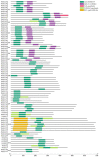
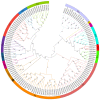

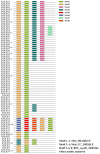


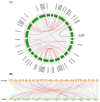




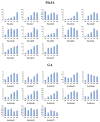
Similar articles
-
Genome-wide identification and expression analysis of SBP-like transcription factor genes in Moso Bamboo (Phyllostachys edulis).BMC Genomics. 2017 Jun 27;18(1):486. doi: 10.1186/s12864-017-3882-4. BMC Genomics. 2017. PMID: 28655295 Free PMC article.
-
Genome-Wide analysis of the AAAP gene family in moso bamboo (Phyllostachys edulis).BMC Plant Biol. 2017 Jan 31;17(1):29. doi: 10.1186/s12870-017-0980-z. BMC Plant Biol. 2017. PMID: 28143411 Free PMC article.
-
Genome-wide identification and expression characterization of the DoG gene family of moso bamboo (Phyllostachys edulis).BMC Genomics. 2022 May 10;23(1):357. doi: 10.1186/s12864-022-08551-3. BMC Genomics. 2022. PMID: 35538420 Free PMC article.
-
Unraveling the intricate tapestry of bamboo transcription factors in abiotic stress signaling and resilience with special reference to moso bamboo family.Biochim Biophys Acta Gen Subj. 2025 Feb;1869(2):130755. doi: 10.1016/j.bbagen.2024.130755. Epub 2024 Dec 29. Biochim Biophys Acta Gen Subj. 2025. PMID: 39740732 Review.
-
Transcriptomic Complexity of Culm Growth and Development in Different Types of Moso Bamboo.Int J Mol Sci. 2023 Apr 18;24(8):7425. doi: 10.3390/ijms24087425. Int J Mol Sci. 2023. PMID: 37108588 Free PMC article. Review.
Cited by
-
The G2-Like gene family in Populus trichocarpa: identification, evolution and expression profiles.BMC Genom Data. 2023 Jul 5;24(1):37. doi: 10.1186/s12863-023-01138-1. BMC Genom Data. 2023. PMID: 37403017 Free PMC article.
-
Genome-Wide Identification of GLK Family Genes in Phoebe bournei and Their Transcriptional Analysis Under Abiotic Stresses.Int J Mol Sci. 2025 Mar 7;26(6):2387. doi: 10.3390/ijms26062387. Int J Mol Sci. 2025. PMID: 40141031 Free PMC article.
-
The pleiotropic functions of GOLDEN2-LIKE transcription factors in plants.Front Plant Sci. 2024 Aug 19;15:1445875. doi: 10.3389/fpls.2024.1445875. eCollection 2024. Front Plant Sci. 2024. PMID: 39224848 Free PMC article. Review.
-
Identification and expression analysis of the GLK gene family in tea plant (Camellia sinensis) and a functional study of CsGLK54 under low-temperature stress.Sci Rep. 2024 May 30;14(1):12465. doi: 10.1038/s41598-024-63323-1. Sci Rep. 2024. PMID: 38816567 Free PMC article.
-
BPG4 regulates chloroplast development and homeostasis by suppressing GLK transcription factors and involving light and brassinosteroid signaling.Nat Commun. 2024 Jan 8;15(1):370. doi: 10.1038/s41467-023-44492-5. Nat Commun. 2024. PMID: 38191552 Free PMC article.
References
MeSH terms
Substances
Grants and funding
LinkOut - more resources
Full Text Sources

